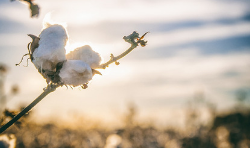In one of our articles from this past summer, we discussed several influences on the price of cotton worldwide, including the commodities markets and several factors related to the grading and classification of cotton based on quality.
Among the factors considered for measuring quality and determining class in a universal sense that’s unbiased by the application were color, uniformity, leaf, staple length, micronaire, strength, and trash content (bark, leaf, and other extraneous matter). For some market applications, such as certain types of fine, expensive clothing, all of these factors may be important. But for other applications, such as those marketed by nonwoven manufacturers, some factors have more importance than those in knitting of woven fabrics.
Let’s take a look at the factors that most affect the quality of cotton in nonwoven fabrics.
Defining Nonwovens
Nonwoven fabrics are much different than woven or knit fabrics or textile fabrics.
Nonwoven fabrics are either carded or airlaid fibers or extruded polymers formed or connected through needling, high-pressure water, chemical bonding, or thermal bonding.
At Barnhardt Manufacturing, many of our Purified Cotton® fibers are used to produce nonwoven fabrics used in hygiene products, specifically in diapers, wipes, and in feminine hygiene pads and liners, replacing synthetic fibers or extruded films in the top sheet next to sensitive skin.
Nonwovens: Different Needs, Different Qualities
In many apparel applications the cotton’s color grade is all important, however, when using Purified Cotton® in nonwoven fabrics, the cotton’s color is not as important due to the innovative purification process. Fiber used in nonwoven fabrics, particularly hygiene applications, should be the purest white. Consumers have been trained to expect white fabrics in hygiene products since the standard has been white synthetics such as polyester or polypropylene. Purified Cotton® provides not only the ultra white appearance but also the purity that consumers expect.
Leaf grade is an extremely important factor when considering cotton for nonwoven hygiene applications. The leaf grade is a visual estimate of the amount of cotton plant leaf particles in the cotton. As noted earlier, consumers expect only the purest white fabric next to their own skin or that of their newborn baby.
Since most nonwoven lines were originally designed for synthetic fibers that are cut to a standard length, fiber length of cotton also becomes an all-important attribute for consideration. Cotton, being a natural fiber, grows to different fiber lengths depending on the seed variety, geography, and growing conditions. Fortunately, each and every bale of cotton ginned in the US is graded for all these attributes, including fiber length, giving us the ability to select the appropriate fiber length for a given application.
Micronaire is another measurable factor when developing blends for nonwoven fabrics. In short, micronaire is the measure of air permeability in compressed cotton fibers. This measure also helps to provide an indication of the fiber fineness & maturity. Typically, a low micronaire cotton measuring 2.8 – 3.4 is the result of a premature frost before the cotton has completely developed. Higher micronaire cotton usually results from drought stress resulting in micronaires of 4.8 and higher. The lower micronaire cotton is soft to the touch while the higher micronaire cotton will feel a bit rougher to the touch. Again, these attributes are important when designing a nonwoven fabric for a specific application such as hygiene.
The USDA (US Dept. of Agriculture) also measures Visual Foreign Matter (VFM) which is a measure of the natural components that are collected when the cotton is harvested from the field such as plant bark or leaf. The amount found in the cotton is noted when the cotton is graded. As the cotton is often replacing synthetic fibers (man-made fiber or artificial fibers), the amount of Extraneous Matter (EM) in the raw cotton is critical for the final product.
Conclusions
The reality for the cotton supply chain, beginning with the cotton producers, harvesters, and then ginners, is understanding the markets where their cotton is going, so that the appropriate measures throughout the planting, growing, harvesting, and ginning of cotton prevents extraneous contamination from becoming part of the raw material. Barnhardt is doing its part, through participation in cotton industry meetings, to discuss the issues concerning extraneous contamination as well as developing and investing in technology integrated into our process to eliminate contaminants.
